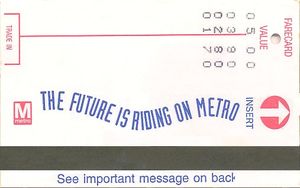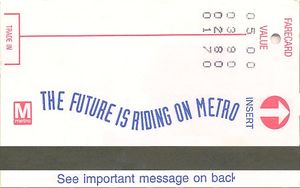Calculating the Expected Value of Metro Fare Evasion
May 22, 2015 •Kevin Danielson

 Every day it seems Washington Metropolitan Area Transit Authority (WMATA) faces new challenges as it attempts to operate and rehabilitate an aging system. And, unfortunately, one of the challenges created by passengers has been a longtime problem for public transportation.
Every day it seems Washington Metropolitan Area Transit Authority (WMATA) faces new challenges as it attempts to operate and rehabilitate an aging system. And, unfortunately, one of the challenges created by passengers has been a longtime problem for public transportation.
Martin Di Caro reports in his WAMU article, “Why Do People Jump Metro Fare Gates? Because They Can” that fare evasions cost WMATA between two and three percent of annual fare revenue. As of 2013, this share estimates to about $19 million or an average of 8.5 million fare evasions (WMATA’s Approved FY 2015 Annual Budget). Stepping up enforcement is an obvious approach, but is it feasible?
Citation Costs & Probability
Di Caro reports the DC first-time offense for fare evasion is a $50 citation and equivalent to the cost of 30 bus or 16 Metro rides. His assumption is fares for bus and Metro rides must average to $1.75 and $3.00, respectively (Mr. Di Caro must not ride the Metro during peak hours). So if a passenger has never received a citation, he must effectively ride the bus for free 30 times before citation or ride the Metro 16 times for free before citation. But these break-even costs do not consider a critical component: citation probability.
Digging deeper, Metro Transit police report the last five years of enforcement efforts on the WMATA website. In 2013, Metro Transit police reported 3,157 fare evasion enforcement efforts, making the ratio of enforcement efforts to fare evasions 3,157 to the aforementioned 8.5 million. Holding other factors such as location and time of day constant, the probability of a first time bus citation is 3,157 to 8.5 million or 0.04%. The probability of a first time Metro citation is 0.08% (the risk of citation doubles because Metro passengers must evade fares on entrance and egress from the system).
Expected Value of Evading a Metro Fare
The first-time offense expected value of fare evasion can be calculated as citation cost times citation probability. Each bus fare evasion expected cost is $0.02 or ($50 x 0.04%). At a $1.75 fare per bus ride, the expected value of each evasion is then $1.75 - $0.02, or a profit of $1.73. Each Metro fare evasion expected cost is $0.04 or ($50 x 0.08%). At a $3.00 fare per Metro ride, the expected value of each evasion is then $3.00 - $0.04, or a profit of $2.96. Thus fare evaders earn a profit after just one evasion—far fewer than the 30 or 16 rides transit authorities claim.
How Can Metro Reduce Fare Evaders?
How much would Metro Transit police have to step up their game to make the expected value of fare evasion negative (not worthwhile)? Quite a bit. Holding all else constant, citation probability for bus fare evasion would need to be at least 3.5% (requiring over 290,000 enforcement efforts). Citation probability for Metro fare evasion would need to be at least 6% (requiring over 250,000 enforcement efforts).
As there were only 93,792 total enforcement efforts reported by Metro Transit police for 2013, a several thousand percent increase in fare enforcement seems neither likely nor cost-effective. A more feasible approach is to increase citation cost such that the expected value of fare evasion, holding all else constant, is negative. To achieve negative expected value, the first time bus and train citation costs would need to be over $4,700 and $4,000, respectively ($4,700 x 0.04% and $4,000 x 0.08%).
While citing almost felony-level fines for first time fare evasion is the economic solution, it can be ruled-out as too politically sensitive. And even increasing the citation cost by a factor of 10 ($500) would still require an over 800% increase in enforcement. So it seems the truly feasible approach is for WMATA to attract more paying passengers in order to further subsidize the rides of fare evaders.
Enjoy this article? Check out Kevin's previous posts.
Get Updates
Featured Articles
Categories
- affordable housing (12)
- agile (3)
- AI (4)
- budget (3)
- change management (1)
- climate resilience (5)
- cloud computing (2)
- company announcements (15)
- consumer protection (3)
- COVID-19 (7)
- data analytics (82)
- data science (1)
- executive branch (4)
- fair lending (13)
- federal credit (33)
- federal finance (4)
- federal loans (4)
- federal register (2)
- financial institutions (1)
- Form 5500 (5)
- grants (1)
- healthcare (17)
- impact investing (12)
- infrastructure (13)
- LIBOR (4)
- litigation (8)
- machine learning (2)
- mechanical turk (3)
- mission-oriented finance (7)
- modeling (9)
- mortgage finance (10)
- office culture (26)
- opioid crisis (5)
- Opportunity Finance Network (4)
- opportunity zones (12)
- partnership (15)
- pay equity (5)
- predictive analytics (15)
- press coverage (3)
- program and business modernization (7)
- program evaluation (29)
- racial and social justice (8)
- real estate (2)
- risk management (10)
- rural communities (9)
- series - loan monitoring and AI (4)
- strength in numbers series (9)
- summer interns (7)
- taxes (7)
- thought leadership (1)
- white paper (15)



